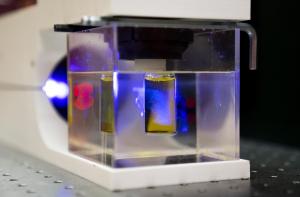LAB REPORT
Science and Technology Making Headlines
Dec. 15, 2017


Melt ponds dot a stretch of sea ice in the Arctic Ocean, north of Greenland. This year was the Arctic's second-warmest in at least 1,500 years, after 2016. Nathan Kurtz/NASA
What happens in the Arctic doesn’t stay in the Arctic
A warmer Arctic could cause more droughts in California.
Lawrence Livermore atmospheric researcher Ivana Cvijanovic ran computer simulations of a warmer Arctic. She found that air circulation over the eastern Pacific could change in a two-step process that ends up steering rain from the Pacific away from California by the end of the century, or even before. "So, on average, it will be 10 to 15 percent drier," she said.
Cvijanovic notes that some years would still be wet and that other weather patterns outside the Arctic, things such as the El Nino weather cycle in the Pacific, could counteract that drying effect. But again, the Arctic effect is powerful. "It's not just a problem for polar bears," she pointed out. "It's not just an isolated problem. It can come back to haunt everyone."
However, Cvijanovic says it's too early to blame the Arctic for California's recent drought. But she says that drought is a good illustration of what the future could bring.


By using laser-generated, hologram-like 3D images flashed into photosensitive resin, researchers at Lawrence Livermore National Laboratory, along with academic collaborators, have discovered they can build complex 3D parts in a fraction of the time of traditional layer-by-layer printing.
3D printing on the fast track
Typical 3D printing must complete one layer at a time, sometimes requiring hours or, at times, days to complete the entire printing process.
However, a Lawrence Livermore team of scientists and engineers have developed a new 3D printing process that uses lasers that are hologram-like to create an entire 3D object in just seconds.
The lasers create the objects inside a tank of liquid resin, and the new technique is called volumetric 3D printing. The team working on the project believes that volumetric 3D printing can overcome many of the limitations seen in current additive manufacturing processes, commonly called 3D printing.


Carbon capture from fossil-fueled power plants may be a stopgap measure to curb carbon emissions. Photo by Gregory Heath/Commonwealth Scientific and Industrial Research Organisation (CSIRO).
The underground road to carbon capture
Julio Friedmann has worked in the private sector, spending five years at ExxonMobil; in the research sector, most recently as the chief energy technologist at the Lawrence Livermore; and in the U.S. government, as principal deputy assistant secretary in the Office of Fossil Energy during the Obama years.
He has a unique view on the need for carbon capture. Carbon capture technology (CCS) stops carbon dioxide emissions from fossil-fuel power plants and chemical industries from entering the atmosphere and buries them safely underground. Friedmann says CCS is an essential stopgap.
According to Friedmann: “A clarifying aspect of the Paris agreement, with 197 countries part of it, is that there is no market in the world where carbon emissions aren’t an issue. Each government is trying to deal with them in one way or another. One of the things they are grappling with is that, despite the progress on renewables and electric vehicles, we are simply not on the right trajectory to reduce our emissions.
“As countries look around and ask, ‘What can we do to hit climate targets,’ the CCS option keeps coming back.”


Using 32- and 64-channel neural probes, LLNL and collaborating researchers were able to demonstrate very long-lasting recordings of spikes from a large number of single neurons in lab rats, collecting information from about 1.1 million neural events per hour.
Scientists have neurons on the brain
Thin-film microelectrode arrays produced at Lawrence Livermore have enabled development of an automated system to sort brain activity by individual neurons, a technology that could open the door to recording and analyzing unprecedented amounts of neural signals over time, and, ultimately, provide scientists with new clues about how the brain learns and communicates.
The work, part of a joint project between the University of San Francisco (UCSF), LLNL and the Flatiron Institute, featured contributions from several current and former LLNL researchers over the past six years. Utilizing a flexible neural probe initially developed at the Lab for an artificial retina and improved and adapted to several brain-related projects, a team led by UCSF neuroscience professor Loren Frank created an algorithm and open-source software suite called "MountainSort," capable of automatically sorting the "spiking" signatures of neural activity picked up by the implanted electrodes.
The scientists hope to answer the question “How does the brain work?”


Lawrence Livermore National Laboratory has joined with partners at other national labs, industry and academia in the Accelerating Therapeutics for Opportunities in Medicine (ATOM) consortium, aimed at creating a new paradigm of cancer drug discovery. Photo by Julie Russell/LLNL
The need for speed
Scientists from two U.S. national laboratories, including Lawrence Livermore, as well as from industry and academia, have launched what they call “an unprecedented effort to transform the way cancer drugs are discovered by creating an open and sharable platform that integrates high-performance computing, shared biological data from public and industry sources and emerging biotechnologies to dramatically accelerate the discovery of effective cancer therapies.”
The goal of the consortium, called Accelerating Therapeutics for Opportunities in Medicine (ATOM), is to create a new paradigm of drug discovery that would reduce the time from an identified drug target to clinical candidate from what is now about six years to just a single year.
The ATOM partners aim to transform cancer drug discovery from “a time-consuming, sequential and high-risk process” into one that “is rapid, integrated and with better patient outcomes.” In part, they plan to do this by using supercomputers to pretest many molecules simultaneously for safety and efficacy.





